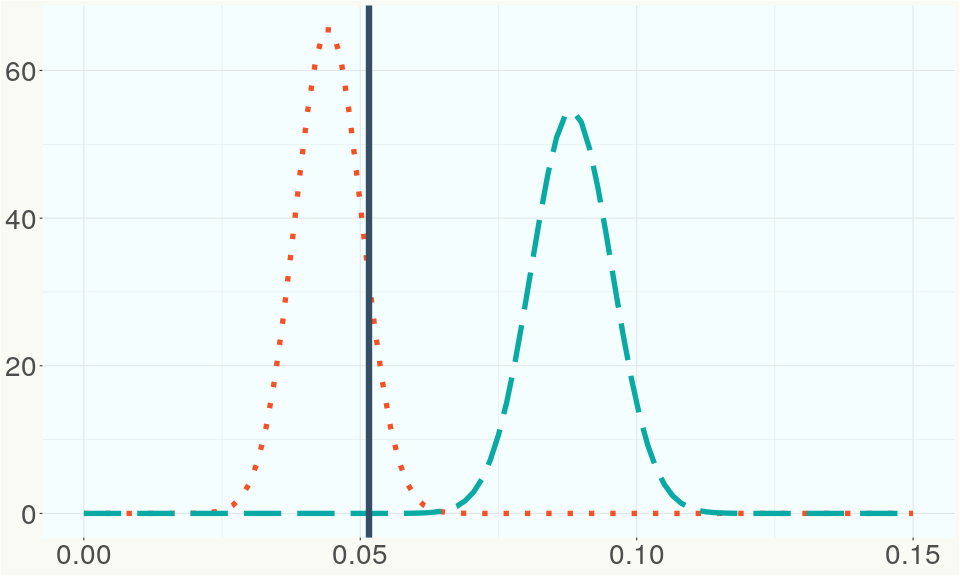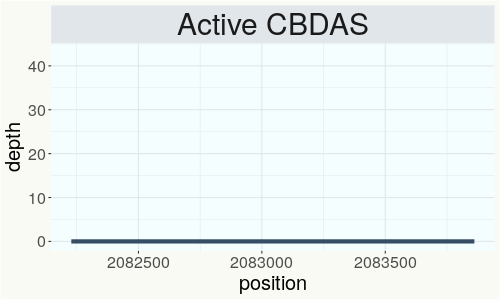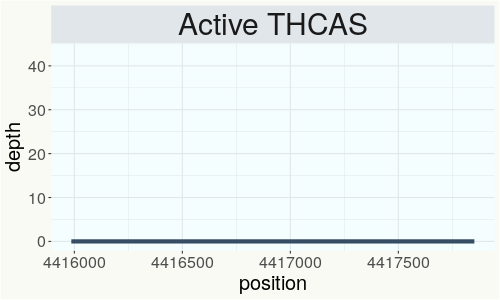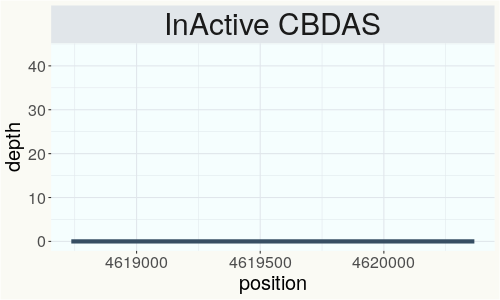Santhica27
RSP 11046
Grower: CSU
General Information
- Sample Name
- Santhica27-2
- Accession Date
- January 7, 2018
- Reported Plant Sex
- Female
- Report Type
- StrainSEEK v2 3.2Mb
- DNA Extracted From
- Leaf
The strain rarity visualization shows how distant the strain is from the other cultivars in the Kannapedia database. The y-axis represents genetic distance, getting farther as you go up. The width of the visualization at any position along the y-axis shows how many strains there are in the database at that genetic distance. So, a common strain will have a more bottom-heavy shape, while uncommon and rare cultivars will have a visualization that is generally shifted towards the top.
Chemical Information
Cannabinoid and terpenoid information provided by the grower.
Cannabinoids
No information provided.
Terpenoids
No information provided.
Genetic Information
- Plant Type
- Type IV
File Downloads
The bell curve in the heterozygosity visualization shows the distribution of heterozygosity levels for cannabis cultivars in the Kannapedia database. The green line shows where this particular strain fits within the distribution. Heterozygosity is associated with heterosis (aka hybrid vigor) but also leads to the production of more variable offspring. When plants have two genetically different parents, heterozygosity levels will be higher than if it has been inbred or backcrossed repeatedly.
The ratio of reads mapped to Y-contigs to reads mapped to the whole Cannabis genome (Y-ratios) has been demonstrated to be strongly correlated with plant sex typing. This plot shows the distribution of Y-ratios for all samples in our database which were sequenced with the same method (panel or WGS) as this sample and where this sample falls in the distribution.

This chart represents the Illumina sequence coverage over the Bt/Bd allele. These are the three regions in the cannabis genome that impact THCA, CBDA, CBGA production. Coverage over the Active CBDAS gene is highly correlated with Type II and Type III plants as described by Etienne de Meijer. Coverage over the THCA gene is highly correlated with Type I and Type II plants but is anti-correlated with Type III plants. Type I plants require coverage over the inactive CBDA loci and no coverage over the Active CBDA gene. Lack of coverage over the Active CBDA and Active THCA allele are presumed to be Type IV plants (CBGA dominant). While deletions of entire THCAS and CBDAS genes are the most common Bt:Bd alleles observed, it is possible to have plants with these genes where functional expression of the enzyme is disrupted by deactivating point mutations (Kojoma et al. 2006).



This chart represents the Illumina sequence coverage over the CBCA synthase gene.

Variants (THCAS, CBDAS, and CBCAS)
No variants to report
Variants (Select Genes of Interest)
| PKSG-2b | c.31A>T | p.Thr11Ser | missense variant | moderate | contig700 | 1951851 | T/A | |
| PKSG-4b | c.523C>T | p.His175Tyr | missense variant | moderate | contig700 | 2721150 | G/A | |
| PKSG-4b | c.489delT | p.Phe163fs | frameshift variant | high | contig700 | 2721183 | CA/C | |
| aPT1 |
c.95_97delGT |
p.Cys32del | disruptive inframe deletion | moderate | contig121 | 2835800 | ATGT/A | |
| aPT1 | c.406A>G | p.Ile136Val | missense variant | moderate | contig121 | 2839605 | A/G |
Nearest genetic relatives (All Samples)
- 0.003 Santhica27 (RSP11047)
- 0.098 Santhica27 (RSP10056)
- 0.118 Santhica 27 (SRR14708211)
- 0.124 Santhica 27 (RSP10665)
- 0.169 Bialobrzeskie (SRR14708244)
- 0.178 Ferimon 12 (SRR14708233)
- 0.180 USO 31 (RSP10983)
- 0.180 Tygra (RSP10667)
- 0.187 Beniko (SRR14708275)
- 0.190 USO 31 (RSP10981)
- 0.190 USO31 (RSP10233)
- 0.193 Futura 75 (RSP10664)
- 0.195 Lovrin (RSP10658)
- 0.197 Ivory (RSP10668)
- 0.197 Fedora 17 (RSP10661)
- 0.199 Monoica (RSP10241)
- 0.199 Fedora 17 (RSP11203)
- 0.203 R1in136 (SRR14708227)
- 0.203 Delta-llosa (SRR14708272)
- 0.204 R1in136 (SRR14708226)
Most genetically distant strains (All Samples)
- 0.449 Cherry Blossom (RSP11312)
- 0.448 Cherry Blossom (RSP11298)
- 0.436 Cherry Blossom (RSP11301)
- 0.431 Cherry Blossom (RSP11323)
- 0.428 Cherry Blossom (RSP11300)
- 0.425 Cherry Blossom (RSP11318)
- 0.420 Cherry Blossom (RSP11311)
- 0.420 Cherry Blossom (RSP11309)
- 0.419 Chem 91 (RSP11185)
- 0.412 Cherry Blossom (RSP11331)
- 0.411 Super Sour Diesel (RSP11191)
- 0.410 Cherry Blossom (RSP11328)
- 0.408 Chematonic -Cannatonic x Chemdawg- (RSP11394)
- 0.407 Cherry Blossom (RSP11319)
- 0.406 AVIDEKEL 2 0 (RSP11174)
- 0.405 RKM-2018-002 (RSP11093)
- 0.405 Cherry Blossom (RSP11322)
- 0.404 Cherry Blossom (RSP11334)
- 0.404 Motor Breath #15 (RSP12093)
- 0.403 CHEM4 (RSP12090)
Nearest genetic relative in Phylos dataset
- Overlapping SNPs:
- 86
- Concordance:
- 59
Nearest genetic relative in Lynch dataset
- Overlapping SNPs:
- 7
- Concordance:
- 6
Blockchain Registration Information
- Transaction ID
-
709801541ccfce7d
058704f3c18ad2e3 cd2d8ae8cc8ad88c 6244a260a81f6684 - Stamping Certificate
- Download PDF (855.2 KB)
- SHASUM Hash
-
23ef9182942c330f668a10377ef97b7f a814177117061486 6f1c52db0d4e8bb1